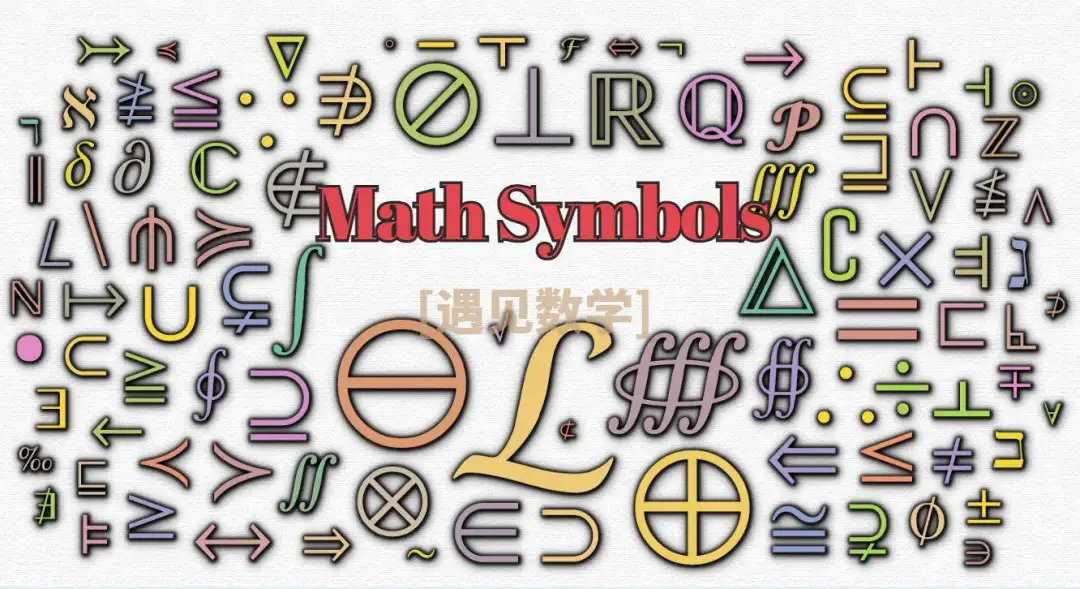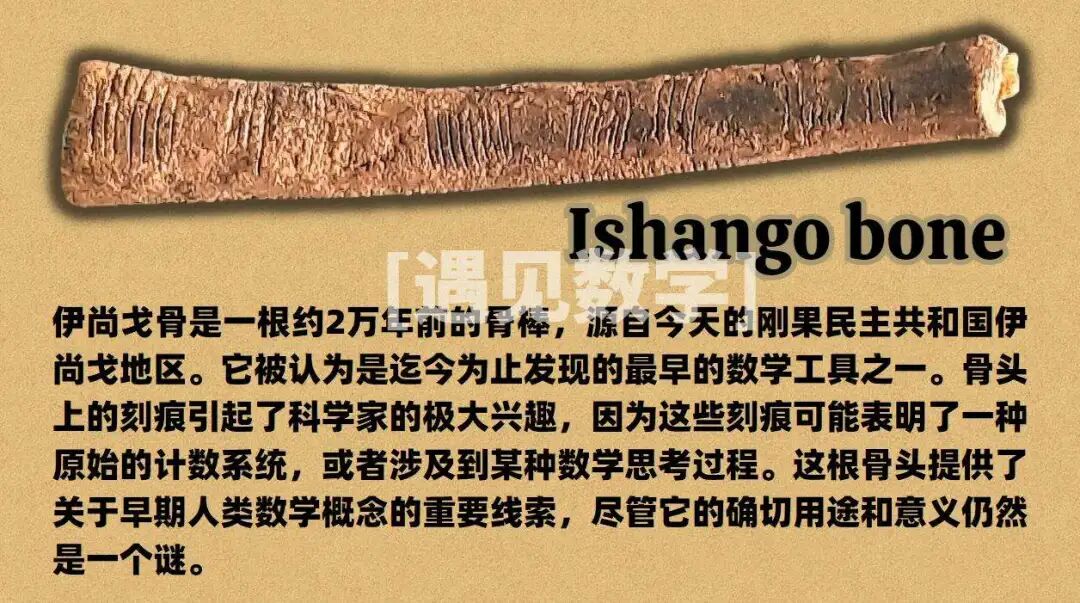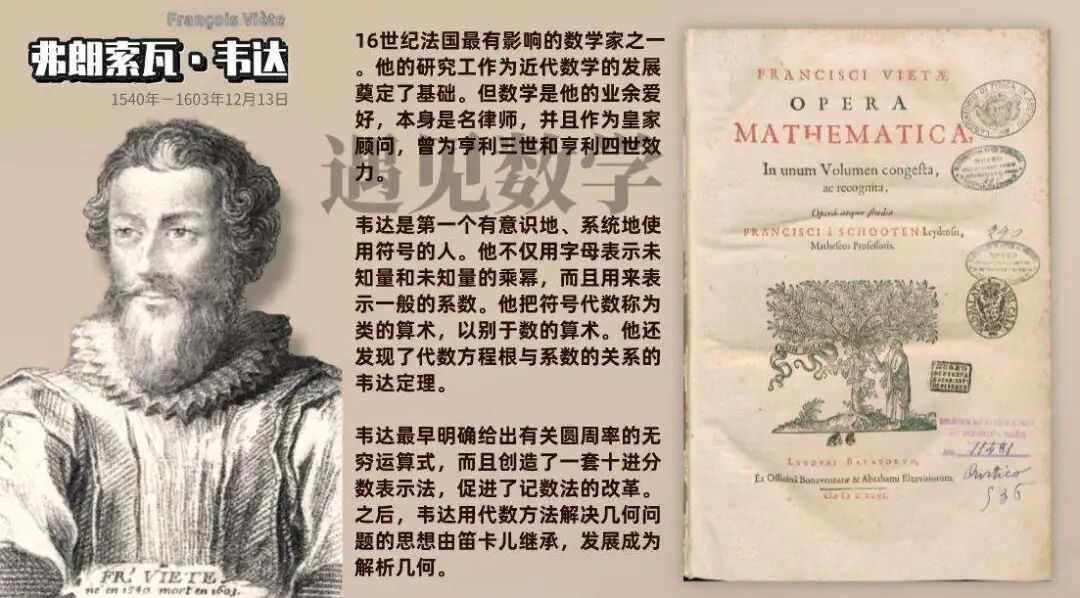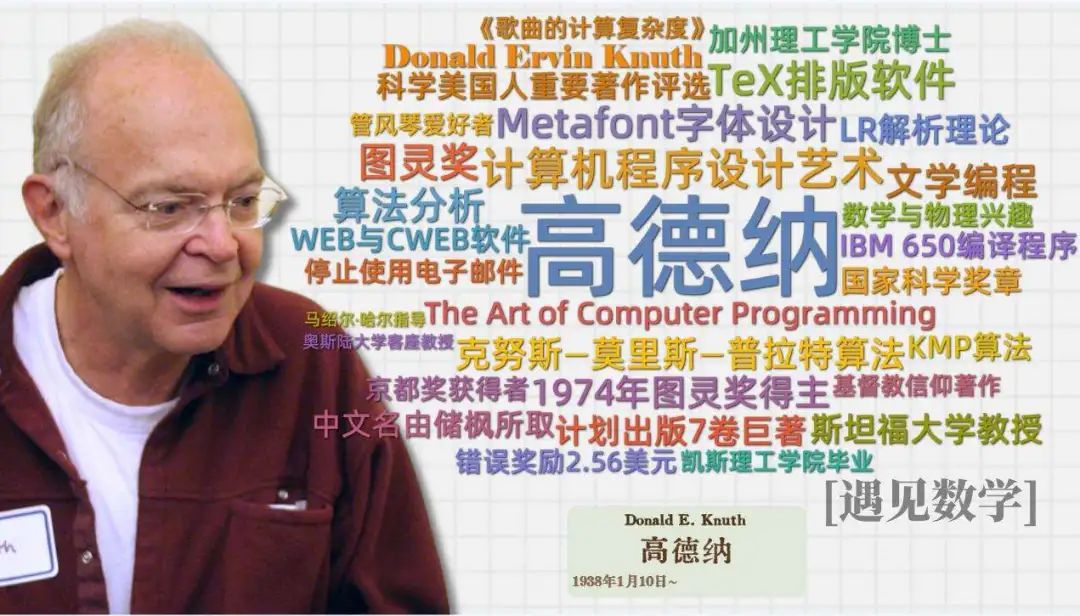注:英文引文,机翻未校,略作重排。
如有内容异常,请看原文。
Some Common Mathematical Symbols and Abbreviations (with History)
一些常见的数学符号与缩写(含历史背景)
Isaiah Lankham, Bruno Nachtergaele, Anne Schilling
(January 21, 2007)
Binary Relations
二元关系
-
= (the equals sign) means “is the same as” and was first introduced in the 1557 book The Whetstone of Witte by Robert Recorde (c. 1510 - 1558). He wrote, ”I will sette as I doe often in woorke use, a paire of parralles, or Gemowe lines of one lengthe, thus : ==, bicause noe 2, thynges, can be moare equalle.” (Recorde used an elongated form of the modern equals sign.)
=(等号)表示“与……相同”,由罗伯特·雷科德(约 1510 - 1558 年)在 1557 年出版的著作《智识之磨》中首次引入。他写道:“在工作中,我会像往常一样使用一对平行线,即长度相同的双生线,写作‘==’,因为没有任何两样东西能比它们更相等了。”(雷科德使用的是现代等号的拉长形式。) -
< (the less than sign) means “is strictly less than”, and > (the greater than sign) means “is strictly greater than”. They first appeared in Artis Analyticae Praxis ad Aequationes Algebraicas Resolvendas (“The Analytical Arts Applied to Solving Algebraic Equations”) by Thomas Harriot (1560 - 1621), which was published posthumously in 1631.
<(小于号)表示“严格小于”,>(大于号)表示“严格大于”。这两个符号由托马斯·哈里奥特(1560 - 1621 年)首次使用,收录于其 1631 年 posthumously(死后)出版的著作《解析术实践:用于求解代数方程》中。 -
Pierre Bouguer (1698 - 1758) later refined these to ≤ (“less than or equals”) and ≥ (“greater than or equals”) in 1734.
皮埃尔·布格(1698 - 1758 年)随后在 1734 年对这两个符号进行改进,提出了 ≤(小于等于号)和 ≥(大于等于号)。 -
:= (the equal by definition sign) means “is equal by definition to”. This is a common alternate form of the symbol “=Def”, which appears in the 1894 book Logica Matematica by the logician Cesare Burali - Forti (1861–1931). Other common alternate forms of the symbol “=Def” include “def =” and ≡, the latter being especially common in applied mathematics.
:=(定义等号)表示“根据定义等于”。它是符号“=Def”的常用替代形式,“=Def”最早出现在逻辑学家切萨雷·布拉利 - 福蒂(1861 - 1931 年)1894 年的著作《数理逻辑》中。“=Def”的其他常见替代形式还包括 “def =” 和 ≡,其中 ≡ 在应用数学中尤为常用。
Some Symbols from Mathematical Logic
数理逻辑中的部分符号
-
∴ (three dots) means “therefore” and first appeared in print in the 1659 book Teusche Algebra (“Teach Yourself Algebra”) by Johann Rahn (1622 - 1676).
∴(三点符号)表示“因此”,由约翰·拉恩(1622 - 1676 年)首次印刷于 1659 年的著作《德语代数》(又名《自学代数》)中。 -
∋ (the such that sign) means “under the condition that”. However, it is much more common (and less ambiguous) to just abbreviate “such that” as “s. t.”.
∋(使得符号)表示“在……条件下”。不过,将“such that”缩写为“s. t.”更为常见,且含义更明确。 -
⇒ (the implies sign) means “logically implies that”. (E.g., “if it’s raining, then it’s pouring” is equivalent to saying “it’s raining ⇒ it’s pouring.”)
⇒(蕴含符号)表示“逻辑上蕴含”。(例如,“如果下雨,那么下大雨”等价于“下雨 ⇒ 下大雨”。) -
The history of this symbol is unclear.
该符号的历史起源尚不明确。 -
⇐⇒ (the iff sign) means “if and only if” and is used to connect logically equivalent statements. (E.g., “it’s raining iff it’s really humid” means simultaneously that “if it’s raining, then it’s really humid” and that “if it’s really humid, then it’s raining”. In other words, the statement “it’s raining” implies the statement “it’s really humid” and vice versa.)
⟺ \iff ⟺(当且仅当符号)表示“当且仅当”,用于连接逻辑等价的命题。(例如,“下雨当且仅当空气非常潮湿”同时表示“如果下雨,那么空气非常潮湿”和“如果空气非常潮湿,那么下雨”。换句话说,“下雨”这个命题蕴含“空气非常潮湿”这个命题,反之亦然。) -
This notation “iff” is attributed to the great mathematician Paul R. Halmos (1916–2006).
“iff”这一符号记法归功于伟大的数学家保罗·R·哈尔莫斯(1916 - 2006 年)。 -
∀ (the universal quantifier symbol) means “for all” and was first used in the 1935 publication Untersuchungen ueber das logische Schliessen (“Investigations on Logical Reasoning”) by Gerhard Gentzen (1909 - 1945). He called it the All - Zeichen (“all character”), in analogy with “∃” (read: “there exists”).
∀(全称量词符号)表示“对所有”,由格哈德·根岑(1909 - 1945 年)在 1935 年的出版物《逻辑推理研究》中首次使用。他将其称为“All - Zeichen”(全称符号),并类比“∃”(读作“存在”)进行命名。 -
∃ (the existential quantifier) means “there exists” and was first used in the 1897 book Formulaire de mathematiques by Giuseppe Peano (1858 - 1932).
∃(存在量词符号)表示“存在”,由朱塞佩·皮亚诺(1858 - 1932 年)在 1897 年的著作《数学公式集》中首次使用。 -
□ (the Halmos tombstone) means “QED”, which is an abbreviation for the Latin phrase quod erat demonstrandum (“which was to be proven”). “QED” has been the most common way to symbolize the end of a logical argument for many centuries, but the modern convention in mathematics is to use the “tombstone” in place of “QED”.
□(哈尔莫斯墓碑符号)表示“QED”,而“QED”是拉丁语短语“quod erat demonstrandum”(意为“需证明之物已证明”)的缩写。几个世纪以来,“QED”一直是标识逻辑论证结束的最常用方式,但在现代数学中,惯例是使用“墓碑符号”替代“QED”。 -
This “tombstone” notation is attributed to the great mathematician Paul R. Halmos (1916–2006).
这种“墓碑符号”记法归功于伟大的数学家保罗·R·哈尔莫斯(1916 - 2006 年)。
Some Notation from Set Theory
集合论中的部分记法
-
⊂ (the is included in sign) means “this set is a subset of” and ⊃ (the includes sign) means “this set has as a subset”. They were introduced in the 1890 book Vorlesungen über die Algebra der Logik (“Lectures on the Algebra of the Logic”) by Ernst Schrödinger (1841 - 1902).
⊂(包含于符号)表示“该集合是……的子集”,⊃(包含符号)表示“该集合包含……作为子集”。这两个符号由恩斯特·施罗德(1841 - 1902 年)在 1890 年的著作《逻辑代数讲义》中引入。 -
∈ (the is in sign) means “is an element of” and first appeared in the 1895 book Formulaire de mathematiques by Giuseppe Peano (1858 - 1932). Peano originally used the Greek letter ϵ (which is the first letter of the Latin word est, meaning “is”), but it was Bertrand Russell (1872 - 1970) in his 1903 Principles of Mathematics that introduced the modern stylized version.
∈(属于符号)表示“是……的元素”,由朱塞佩·皮亚诺(1858 - 1932 年)首次使用于 1895 年的著作《数学公式集》中。皮亚诺最初使用的是希腊字母 ϵ(它是拉丁语单词“est”(意为“是”)的首字母),而现代风格的 ∈ 符号则由伯特兰·罗素(1872 - 1970 年)在其 1903 年的著作《数学原理》中提出。 -
∪ (the union sign) means “take the elements that are in either set”, and ∩ (the intersection sign) means “take the elements that the two sets have in common”. They were introduced in the 1888 book Calcolo geometrico secondo l’Ausdehnungslehre di H. Grassmann preceduto dalle operazioni della logica deduttiva (“Geometric Calculus based upon the teachings of H. Grassmann, preceded by the operations of deductive logic”) by Giuseppe Peano (1858 - 1932).
∪(并集符号)表示“取两个集合中的所有元素”,∩(交集符号)表示“取两个集合共有的元素”。这两个符号由朱塞佩·皮亚诺(1858 - 1932 年)在 1888 年的著作《基于 H. 格拉斯曼外延理论的几何演算——演绎逻辑运算先导》中引入。
-
∅ (the null set or empty set symbol) means “the set without any elements in it” and was first used in the 1939 book Éléments de mathématique by N. Bourbaki (a group of primarily European mathematicians - not a single person). It was borrowed simultaneously from the Norwegian, Danish and Faroese alphabets by group member André Weil (1906 - 1998).
∅(空集符号)表示“不包含任何元素的集合”,由尼古拉·布尔巴基(并非单一个人,而是以欧洲数学家为主的学术团体)在 1939 年的著作《数学原理》中首次使用。该符号由团体成员安德烈·韦伊(1906 - 1998 年)同时借鉴挪威语、丹麦语和法罗语字母表创造而来。 -
∞ (infinity) denotes “a number of arbitrarily large magnitude” and first appeared in print in the 1655 book De Sectionibus Conicus (“On Conic Section”) by John Wallis (1616 - 1703). Conjectured explanations for why Wallis used this symbol include its resemblance to the symbol oo used by Romans to denote the number 1000, its resemblance to the final letter of the Greek alphabet ω (and so is synonymous with being the “final” number), and the symbolism of the fact that one can traverse a given curve infinitely often.
∞(无穷大符号)表示“数值大小可任意大的量”,由约翰·沃利斯(1616 - 1703 年)首次印刷于 1655 年的著作《圆锥曲线论》中。关于沃利斯为何使用该符号,目前有几种推测性解释:一是它与罗马人表示数字 1000 的符号“oo”相似;二是它与希腊字母表的最后一个字母 ω 相似(因此象征“最终的数字”);三是其象征意义——人们可以无限次遍历某一给定曲线。
Some Important Numbers in Mathematics
数学中的部分重要常数
-
π (the ratio of the circumference to the diameter of a circle) denotes the number 3.141592653589… , and was first used by William Jones (1675 - 1749) in his 1706 book Synopsis palmariorum mathesios (“A New Introduction to the Mathematics”). However, it was Leonhard Euler (1707 - 1783) who first popularized the use of the letter π for this number in his 1748 book Introductio in Analysin Infinitorum.
π(圆周率,即圆的周长与直径的比值)表示数值 3.141592653589……,由威廉·琼斯(1675 - 1749 年)在其 1706 年的著作《数学概要》(又名《数学新导论》)中首次使用。不过,将字母 π 作为圆周率的标准符号并推广开来的是莱昂哈德·欧拉(1707 - 1783 年),他在 1748 年的著作《无穷分析引论》中首次普及了这一用法。 -
Many people speculate that Jones chose the letter π because it’s the first letter in Greek word perimetron (πϵριµϵτρoν), which roughly means “around”.
许多人推测,琼斯选择字母 π 是因为它是希腊语单词“perimetron”(πϵριµϵτρoν,大致意为“周围、周长”)的首字母。 -
e = lim n → ∞ ( 1 + 1 n ) n e = \lim_{n \to \infty} \left(1 + \frac{1}{n}\right)^n e=limn→∞(1+n1)n (the natural logarithm base) denotes the number 2.718281828459… , and was first used by Leonhard Euler (1707 - 1783) in the manuscript Meditatio in Experimenta explosione tormentorum nuper instituta (“Meditation on experiments made recently on the firing of cannon”), written when he was just 21 years old. (Note that e is the first letter in exponential.)
e = lim n → ∞ ( 1 + 1 n ) n e = \lim_{n \to \infty} \left(1 + \frac{1}{n}\right)^n e=limn→∞(1+n1)n(自然对数的底数)表示数值 2.718281828459……,由莱昂哈德·欧拉(1707 - 1783 年)在其 21 岁时撰写的手稿《对近期火炮发射实验的思考》中首次使用。(注:e 是“exponential”(指数)一词的首字母。) -
The very famous mathematician Edmund Landau (1877 - 1938) once wrote that “The letter e may now no longer be used to denote anything other than this positive universal constant.”
著名数学家埃德蒙·朗道(1877 - 1938 年)曾写道:“如今,字母 e 只能用来表示这个正的普适常数,不能再表示其他任何事物。” -
γ = lim n → ∞ ( ∑ k = 1 n 1 k − ln n ) \gamma = \lim_{n \to \infty} \left(\sum_{k = 1}^n \frac{1}{k} - \ln n\right) γ=limn→∞(∑k=1nk1−lnn) (the Euler - Mascheroni constant) denotes the number 0.577215664901… , and was first used by Lorenzo Mascheroni (1750 - 1800) in his 1792 Adnotationes ad Euleri Calculum Integralem (“Annotations to Euler’s Integral Calculus”).
γ = lim n → ∞ ( ∑ k = 1 n 1 k − ln n ) \gamma = \lim_{n \to \infty} \left(\sum_{k = 1}^n \frac{1}{k} - \ln n\right) γ=limn→∞(∑k=1nk1−lnn)(欧拉 - 马歇罗尼常数)表示数值 0.577215664901……,由洛伦佐·马歇罗尼(1750 - 1800 年)在其 1792 年的著作《欧拉积分演算注释》中首次使用。 -
The number γ is usually considered to be the third most important non - basic number in mathematics, following closely π and e.
在数学中,常数 γ 通常被认为是第三重要的非基础常数,仅次于 π 和 e。 -
i = − 1 i = \sqrt{-1} i=−1 (imaginary unit) was first used by Leonhard Euler (1707 - 1783) in his 1777 memoir Institutionum calculi integralis (“Foundations of Integral Calculus”).
i = − 1 i = \sqrt{-1} i=−1(虚数单位)由莱昂哈德·欧拉(1707 - 1783 年)在其 1777 年的论文《积分演算基础》中首次使用。
Appendix: Some Common Latin Abbreviations and Phrases
附录:一些常见的拉丁语缩写与短语
(Cf. also 另参见:http://en.wikipedia.org/wiki/List_of_Latin_phrases)
-
i.e. (id est) means “that is” or “in other words”. (It is used to paraphrase a statement that was just made, not to mean “for example”, and is always followed by a comma.)
i.e.(id est)表示“即”或“换句话说”。(用于解释刚提出的陈述,而非表示“例如”,且其后始终需加逗号。) -
e.g. (exempli gratia) means “for example”. (It is usually used to give an example of a statement that was just made and is always followed by a comma.)
e.g.(exempli gratia)表示“例如”。(通常用于为刚提出的陈述举例,且其后始终需加逗号。) -
viz. (videlicet) means “namely” or “more specifically”. (It is used to clarify a statement that was just made by providing more information and is never followed by a comma.)
viz.(videlicet)表示“即”或“更具体地说”。(用于通过补充信息明确刚提出的陈述,其后从不加逗号。) -
etc. (et cetera) means “and so forth” or “and so on”. (It is used to suggest that the reader should infer further examples from a list that has been started and is usually not followed by a comma.)
etc.(et cetera)表示“等等”或“诸如此类”。(用于提示读者从已列出的内容中推断出更多例子,其后通常不加逗号。) -
et al. (et alii) means “and others”. (It is used in place of listing multiple authors past the first and is never followed by a comma.) It’s also an abbreviation for et alibi means “and elsewhere”.
et al.(et alii)表示“以及其他人”。(用于替代列出第一位作者之后的多位作者,其后从不加逗号。)它同时也是“et alibi”的缩写,意为“以及其他地方”。 -
cf. (conferre) means “compare to” or “see also”. (It is used either to draw a comparison or to refer the reader to somewhere they can find more information and is never followed by a comma.)
cf.(conferre)表示“与……比较”或“另见”。(既可用于引导比较,也可用于指引读者查阅更多信息的出处,其后从不加逗号。) -
q.v. (quod vide) means “which see” or “go look it up if you’re interested”. (It is used to cross - reference a different work or part of a work and is never followed by a comma. The plural form is “q.q.”)
q.v.(quod vide)表示“参见该内容”或“如有兴趣可查阅”。(用于交叉引用其他著作或同一著作的其他部分,其后从不加逗号,其复数形式为“q.q.”。) -
v.s. (vide supra) means “see above”. (It is used to imply that more information can be found before the current point in a written work and is never followed by a comma.)
v.s.(vide supra)表示“见上文”。(用于提示读者可在当前文本位置之前找到更多相关信息,其后从不加逗号。) -
N.B. (Nota Bene) means “note well” or “pay attention to the following”. (It is used to imply that the wise reader will pay especially careful attention to what follows and is never followed by a comma.)
N.B.(Nota Bene)表示“请注意”或“务必关注以下内容”。(用于提示明智的读者需特别留意后续内容,其后从不加逗号。) -
vs. (versus) means “against” or “in contrast to”. (It is used to contrast two things and is never followed by a comma.)
vs.(versus)表示“与……对立”或“与……对比”。(用于对比两个事物,其后从不加逗号。) -
c. (circa) means “around” or “near”. (It is used when giving an approximation, usually for a date, and is never followed by a comma. It’s also commonly written as “ca.”, “cir.”, or “circ.”)
c.(circa)表示“大约”或“接近”。(用于表示近似值,通常用于日期,其后从不加逗号,也常写作“ca.”“cir.”或“circ.”。) -
ex lib. (ex libris) means “from the library of”. (It is used to indicate ownership of a book and is never followed by a comma.)
ex lib.(ex libris)表示“来自……的藏书”。(用于标明书籍的归属,其后从不加逗号。) -
a fortiori means “from the stronger” or “more importantly”.
a fortiori(拉丁语短语)表示“更有理由地”或“更重要的是”。 -
a priori means “from before the fact” and refers to reasoning done before an event happens.
a priori(拉丁语短语)表示“先验的”,指在事件发生前进行的推理。 -
a posteriori means “from after the fact” and refers to reasoning done after an event happens.
a posteriori(拉丁语短语)表示“后验的”,指在事件发生后进行的推理。 -
ad hoc means “to this” and refers to reasoning that is quite specific to an event as it is happening. Such reasoning is usually considered to not generalize to other situations very well.
ad hoc(拉丁语短语)表示“为此”,指针对正在发生的特定事件所进行的推理。这类推理通常被认为难以推广到其他情况。 -
ad infinitum means “to infinity” or “without limit”.
ad infinitum(拉丁语短语)表示“无限地”或“无限制地”。 -
ad nauseam means “causing sea - sickness” or “to excess”.
ad nauseam(拉丁语短语)表示“令人作呕地”或“过度地”。 -
mutatis mutandis means “changing what needs changing” or “with the necessary changes”.
mutatis mutandis(拉丁语短语)表示“在作必要修改的情况下”或“根据需要进行调整后”。 -
non sequitur means “it does not follow” and refers to something that is out of place in a logical argument. (This is sometimes abbreviated as “non seq.”)
non sequitur(拉丁语短语)表示“不合逻辑的推论”,指在逻辑论证中不符合逻辑的内容。(有时缩写为“non seq.”。) -
Me transmitte sursum, Caledoni! means “Beam me up, Scotty!”.
Me transmitte sursum, Caledoni!(拉丁语句子)表示“把我传送上去,史考提!”(源自《星际迷航》中的经典台词)。 -
Quid quid latine dictum sit, altum videtur means “Anything said in Latin sounds profound”.
Quid quid latine dictum sit, altum videtur(拉丁语句子)表示“任何用拉丁语说的话,听起来都很深奥”。
Copyright ©2007 by the authors. These lecture notes may be reproduced in their entirety for non - commercial purposes.
数学符号背后的故事:一篇文章带你了解人类最精确语言系统的起源与现代应用
原创 遇见数学 遇见数学 2025年05月06日20:03 河南
数学符号通过特定符号来表示运算、未确定的数、各种关系以及其他数学对象,将其组合成表达式和公式。这套符号系统使我们能够以简洁、明确且准确的方式表达复杂的概念和性质,就像是一种专为精准思考设计的语言。
数学符号的价值远超数学领域,它在科学、工程甚至经济学等领域都扮演着不可替代的角色。通过数学符号,我们能够把抽象的思想转化为可以操作的形式,进行推理和计算。

例如,物理学家阿尔伯特·爱因斯坦的公式 E = m c 2 E = mc^2 E=mc2 就是质能等价关系的数学表示——简洁地表达了质量与能量之间深刻的等价关系。
数学符号是经过漫长的历史发展逐步完善的。16世纪末,弗朗索瓦·韦达首次系统地用字母表示未知数,奠定了代数符号的雏形,并在17、18世纪由勒内-笛卡尔(Rene Descartes)、艾萨克·牛顿(Isaac Newton)、戈特弗里德·威廉·莱布尼茨(Gottfried Wilhelm Leibniz)等数学家进一步发展和完善。正是这些数学巨匠们的贡献,才形成了我们今天使用的大部分数学符号体系,使得数学表达变得更加系统化和规范化。
符号与字体:数学的文字系统
符号的多样性与作用
数学符号就像是数学语言中的词汇,它们共同构成了一个丰富而精确的表达系统。在这个系统中,不同的符号扮演着不同的角色,有些表示数学对象(如变量、常数),有些表示运算(如加减乘除),有些表示关系(如等于、大于),这与自然语言中的名词、动词、形容词有着相似的功能区分。
字母作为符号
字母是数学符号中最基础的元素,主要用于命名或表示数学对象。数学家们借用了拉丁字母和希腊字母作为主要工具,有时还会使用其他文字系统中的字母,如希伯来字母。
在数学的世界里,大写和小写字母被视为完全不同的符号。更有趣的是,不同的字体也赋予了字母不同的含义。例如, r r r、 R R R、 R \mathbb{R} R、 R \mathcal{R} R、 R \mathfrak{R} R 和 r ⃗ \vec{r} r 这六个看似相关的符号,在数学文本中可能代表完全不同的概念。其中 R \mathbb{R} R 通常表示实数集, R \mathcal{R} R 可能表示某种关系,而其他形式则可能有各自特定的含义。
通常情况下,罗马直立字体保留给特定的数学函数,如正弦函数“ sin \sin sin”、余弦函数“ cos \cos cos”或对数函数“ log \log log”等。这种字体上的区分帮助读者快速识别出函数名与变量的区别。
数学家们还巧妙地运用变音符号、下标和上标来扩展符号系统。比如 f ^ 1 ′ \hat{f}_{1}' f^1′ 这个复合符号,可通过多层修饰精确表达特定数学概念,使符号系统更加系统化和直观。
其他符号
除了用字母表示对象外,数学还需要表示各种运算和关系。例如:
- 运算符号: + + +、 − - −、 × \times ×、 / / /、 \sqrt{} 、 ∫ \int ∫ 等
- 关系符号: = = =、 < < <、 > > >、 ≈ \approx ≈、 ≡ \equiv ≡、 ∼ \sim ∼ 等
- 逻辑符号: → \rightarrow →、 ∧ \land ∧、 ∨ \lor ∨、 ¬ \neg ¬ 等
- 量词符号: ∀ \forall ∀(对所有)、 ∃ \exists ∃(存在)等
这些符号有些源自传统排版符号,有些是字母的变形,还有很多是专门为数学创造的,它们共同构成了数学的表达工具箱。
国际标准数学符号
为了保证数学符号在全球范围内的一致性,国际标准化组织(ISO)制定了相关标准。ISO 80000-2(之前为 ISO 31-11)规定了数学方程中符号的使用规范。
这些标准不仅仅是形式上的约定,它们对数学沟通的准确性至关重要。例如,标准要求在表示变量时使用斜体(如等式 E = m c 2 E = mc^2 E=mc2 中的 E E E、 m m m 和 c c c),而表示数学常数时则使用罗马(直立)字体(如自然对数的底 e e e 或圆周率 π \pi π)。这种细微的区别帮助读者区分变量和固定值,减少了歧义。
表达式和公式
在数学语言中,表达式和公式是两个核心概念,它们与自然语言中的名词短语和句子有着相似的关系。
表达式是按照数学语法规则组合起来的符号序列,它代表一个数学对象(如数、向量或函数)。例如 8 x − 5 8x - 5 8x−5 是一个代表特定数值的表达式,具体数值取决于变量 x x x 的值。
公式则是关于数学对象的陈述,通常包含等号或不等号等关系符号。比如不等式 8 x − 5 ≥ 3 8x - 5 \geq 3 8x−5≥3 是一个公式,它表达了一个可以判断真假的命题。
当我们处理表达式时,常见的操作是求值或简化。求值意味着找到表达式的具体数值,而简化则是将表达式转换为等价但形式更简单的表达式。例如,表达式 8 × 2 − 5 8 \times 2 - 5 8×2−5 可以简化为 11 11 11。
数学符号的历史演变
数字的起源

伊尚戈骨(Ishango bone)是一根约 2 万年前的骨棒,源自今天的刚果民主共和国伊尚戈地区。它被认为是迄今为止发现的最早的数学工具之一。骨头上面的刻痕引起了科学家的极大兴趣,因为这些刻痕可能表明了一种原始的计数系统,或者涉及到某种数学思考过程。这根骨头提供了关于早期人类数学概念的重要线索,尽管它的确切用途和意义仍然是一个谜。
人类表示数量的历史可以追溯到至少 5 万年前。早期人类通过手指计数、石头、木棍、骨头、结绳等物理方式记录数量。著名的历史例证包括非洲的伊尚戈骨和安第斯地区的绳结计数系统(Quipu),这些都是早期数学符号的雏形。
零的概念及符号的引入是数学史上的重大突破,它比零作为数字的概念早了几个世纪。最初,它在巴比伦和埃及被用作占位符,后来在玛雅、印度和阿拉伯数学中发展成为完整的数字概念。这一发展对数学和科学的进步产生了深远影响。
现代符号体系的形成
在 16 世纪之前,数学表达主要依靠文字描述,即使是复杂的数学关系也需要用冗长的文字来表达。丢番图等少数数学家虽然尝试使用简写符号,但没有形成系统的符号体系。

弗朗索瓦·韦达(1540 年 - 1603 年 2 月 13 日)是 16 世纪法国最有影响的数学家之一,他的研究工作为近代数学的发展奠定了基础。但数学只是他的业余爱好,他本身是一名律师,并且担任过皇家顾问。韦达是第一个有意识地、系统地使用符号的人。他不仅用字母表示未知量和未知量的乘幂,还用来表示一般的系数。他把符号代数称为“类的算术”,以别于“数的算术”。他还发现了代数方程根与系数的关系的韦达定理。此外,韦达最早明确给出有关圆周率的无穷运算式,而且创造了一套十进分数表示法,促进了记数法的改革。之后,韦达用代数方法解决几何问题的思想由笛卡尔继承,发展成为解析几何。
真正的变革始于 16 世纪末,由法国数学家弗朗索瓦·韦达开创了代数符号的系统使用,特别是引入了字母表示未知数。随后,17 世纪的勒内 - 笛卡尔奠定了现代数学符号的基础,他引入了使用 x x x、 y y y、 z z z 表示未知数, a a a、 b b b、 c c c 表示已知数(常数)的惯例,这一做法一直沿用至今。他还引入了虚数单位 i i i 及“虚数”(imaginary)这一术语。
18 和 19 世纪见证了数学符号的标准化过程。莱昂哈德·欧拉作出了卓越贡献,他创造或推广了众多现代数学符号,包括函数符号 f ( x ) f(x) f(x)、自然对数的底 e e e、求和符号 ∑ \sum ∑ 等。他还普及了威廉·琼斯提出的使用 π \pi π 表示圆周率的做法。
此后,随着数学分支的不断发展,许多新符号被引入,有些以其发明者命名,如莱布尼茨的微积分符号( d y d x \frac{dy}{dx} dxdy、 ∫ \int ∫)、勒让德符号( ( a p ) \left(\frac{a}{p}\right) (pa))、爱因斯坦求和约定等,丰富了数学的表达能力。
数学排版的艺术
数学表达的二维结构特性使得普通排版系统难以胜任数学内容的呈现。例如,下面这个表达式:
∑
n
=
0
∞
[
a
b
c
d
]
n
n
!
\sum_{n=0}^{\infty} \frac{\begin{bmatrix} a & b \\ c & d \end{bmatrix}^{n}}{n!}
n=0∑∞n![acbd]n
为解决这一难题,高德纳(Donald Knuth)于 1978 年创建了 TeX 排版系统,特别适合处理复杂的数学表达式。通过其扩展 LaTeX,它已成为数学和科学出版的事实标准。上面展示的复杂表达式就是用 LaTeX 代码编写的。

高德纳(Donald E. Knuth),1938 年 1 月 10 日出生,凯斯理工学院毕业,加州理工学院博士,斯坦福大学教授,奥斯陆大学客座教授。他是管风琴爱好者,对 Metafont 字体设计、LR 解析理论有深入研究,其著作《计算机程序设计艺术》(The Art of Computer Programming)计划出版 7 卷,曾入选《科学美国人》重要著作评选。他在算法分析领域贡献卓著,发明了克努斯-莫里斯-普拉特算法(KMP 算法),提出“文学编程”理念,开发了 WEB 与 CWEB 软件、TeX 排版软件,还撰写了《歌曲的计算复杂度》等作品。他信仰基督教,中文名由储枫所取,1974 年获得图灵奖,还曾获国家科学奖章、京都奖等荣誉,曾在 IBM 650 计算机上开发编译程序,并且有“错误奖励 2.56 美元”的有趣举措,晚年停止使用电子邮件。
近年来,为了适应网络环境,MathML 提供了另一种数学排版方案,但其在网页浏览器中的支持仍有限制,尚未完全普及。
非拉丁语系数学符号
现代阿拉伯数学符号主要基于阿拉伯字母,在阿拉伯世界广泛使用,尤其是在高等教育前阶段。
阿拉伯国家,尤其是在大学之前,数学并不总是使用我们习惯的西方数学符号系统(如 x x x、 + + +、 = = = 等),而是用建立在阿拉伯语文字系统之上的数学符号体系。
除了阿拉伯符号,数学还使用希腊字母来表示各种各样的数学对象和变量(如 α \alpha α、 β \beta β、 γ \gamma γ、 Δ \Delta Δ 等)。在某些情况下,也使用一些希伯来字母(如在无限基数的上下文中使用 ℵ \aleph ℵ)。
一些数学符号主要是图示性的,因此几乎完全独立于文字。例如潘洛斯图形符号和科克斯特 - 邓肯图。
潘洛斯图形符号(Penrose graphical notation):用于量子物理和张量网络的可视化。它用图形表示张量及其收缩过程,简化了繁复的代数表达。
科克斯特 - 邓肯图(Coxeter - Dynkin diagram):用于描述李群、李代数及抽象根系的结构,通过节点和连线的组合直观呈现数学对象的内在关系。
盲人使用的数学符号
盲人使用的基于盲文的数学符号包括 Nemeth 盲文和 GS8 盲文,这些符号系统通过特定的盲文点位组合,帮助视障人群理解和表达数学概念。
数学符号软件

▲ 突出显示的 LaTeX 数学符号
随着计算机技术的发展,多种工具被开发用于处理和展示数学符号:
- TeX/LaTeX:最强大的数学排版系统,被学术界广泛采用
- MathJax:用于在网页上显示数学公式的 JavaScript 库
- KaTeX:一个快速的数学排版库,适用于网页
- MathML:用于在网页上描述数学符号的 XML 标记语言
- AsciiMath:一种简化的数学符号输入系统
- LibreOffice Math:开源办公软件中的公式编辑器
- GNU TeXmacs:科学文档的所见即所得编辑器
原内容及图片源自维基百科,遵循 CC BY - SA 4.0 协议。
原文:https://en.wikipedia.org/wiki/Mathematical_notation
翻译:【遇见数学】译制,并补充部分内容/图片
via:
-
mat67-Common_Math_Symbols.pdf
https://www.math.ucdavis.edu/~anne/WQ2007/mat67-Common_Math_Symbols.pdf -
数学符号背后的故事:一篇文章带你了解人类最精确语言系统的起源与现代应用
https://mp.weixin.qq.com/s/B3qKOaRYiMxdozaZXU3Nww





















 1655
1655

 被折叠的 条评论
为什么被折叠?
被折叠的 条评论
为什么被折叠?








